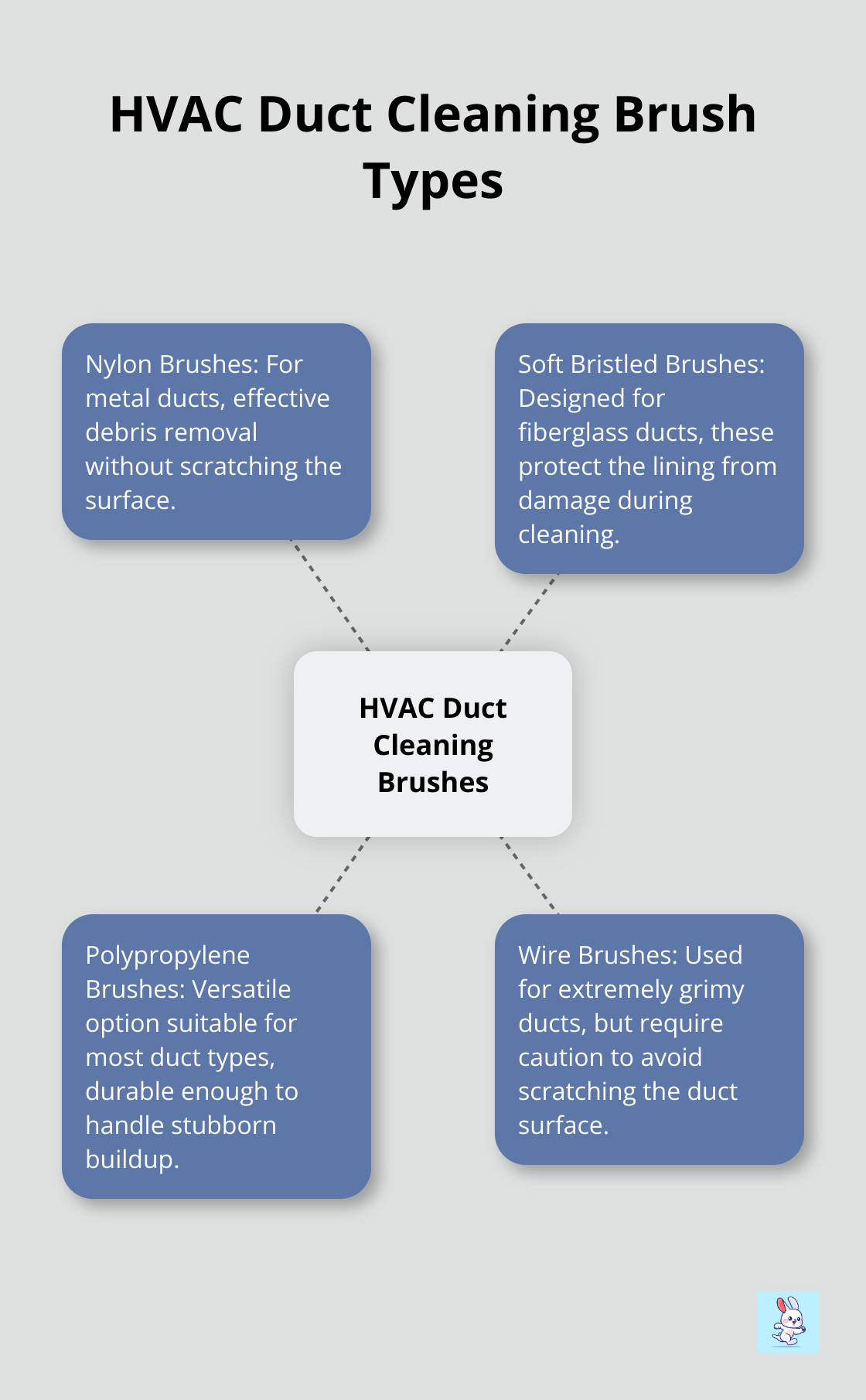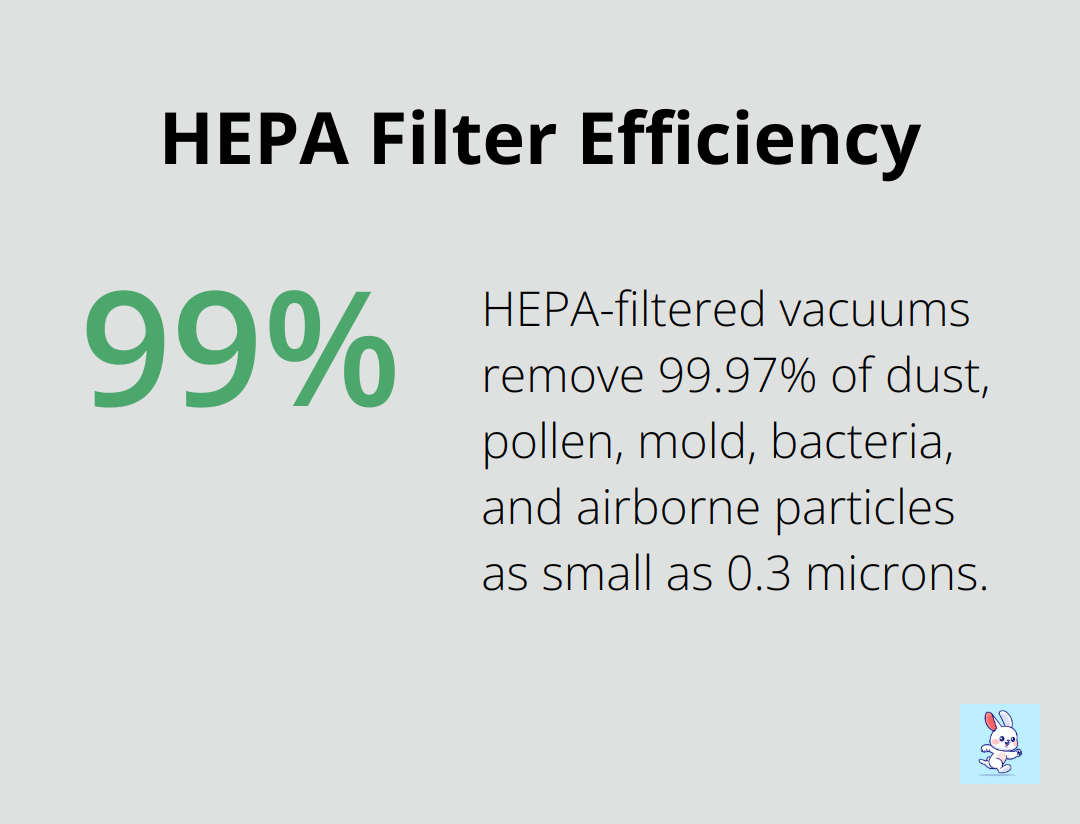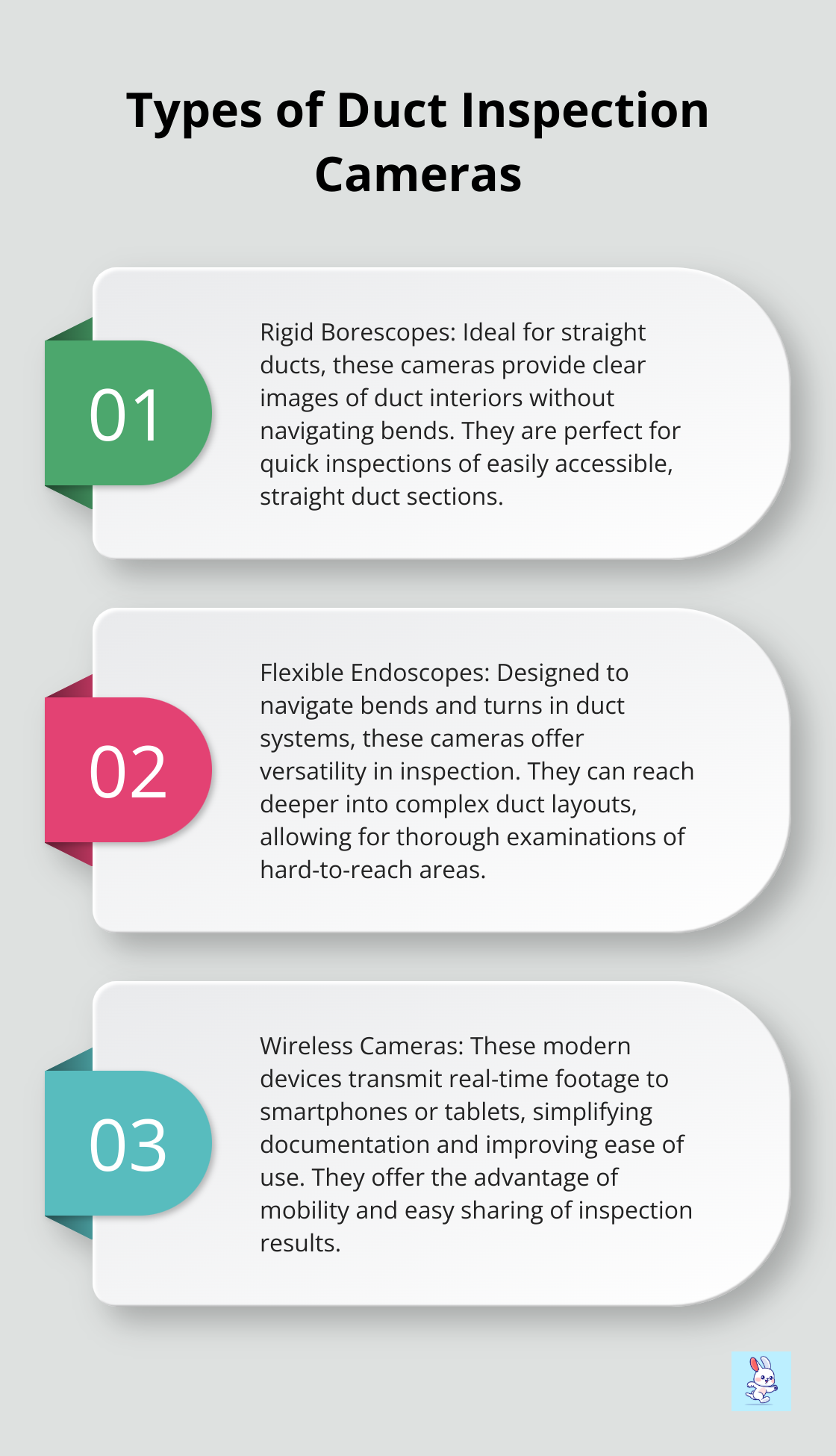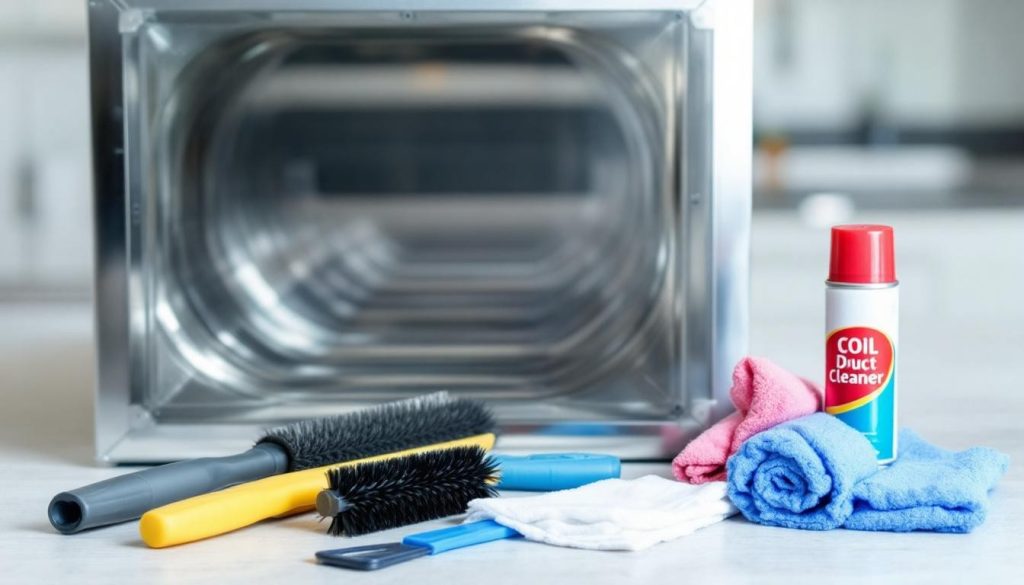At Cleaning Rabbit, we know that maintaining clean HVAC ducts is crucial for optimal air quality in your home.
Proper tools are essential for effective HVAC evaporator cleaning and duct maintenance. This guide will introduce you to the must-have equipment for homeowners looking to tackle this important task.
From brushes and vacuums to inspection cameras, we’ll cover everything you need to keep your ducts in top shape.
What Brushes and Rods Do You Need for HVAC Duct Cleaning?
Types of Brushes for Different Duct Materials
HVAC duct cleaning brushes and rods form the backbone of any effective duct cleaning toolkit. The material of your ducts determines the type of brush you should use. Metal ducts, common in many homes, require nylon brushes. These brushes remove debris effectively without scratching the metal surface. For fiberglass ducts, use softer bristled brushes to protect the lining from damage.
Polypropylene brushes offer versatility and work well for most duct types. Their durability allows them to handle stubborn buildup without causing damage. Wire brushes can tackle particularly grimy ducts, but use them with caution to avoid scratching.

The Importance of Flexible Rods
Flexible rods allow you to navigate the twists and turns in your duct system. These connectors are crimped on both ends, which makes them flexible and easy to use. Some professional-grade rods extend up to 50 feet or more, which proves essential for larger homes or commercial buildings.
Look for rods with quick-connect ends. This feature allows you to add length as needed, ensuring you reach every part of your duct system.
How to Choose the Right Brush Size
Brush size plays a critical role in effective cleaning. A brush that’s too small won’t make proper contact with the duct walls, leaving debris behind. On the other hand, a brush that’s too large can get stuck or damage the ducts.
Measure the diameter of your ducts before purchasing brushes. It’s important to determine the real pressure drop and velocity on the selected duct size. Space the takeoffs at least 6 inches apart and 12 inches from the end cap.
For round ducts, choose brushes slightly larger than the duct diameter to ensure good contact. For square or rectangular ducts, opt for brushes that can reach into corners.
Professional vs. DIY Duct Cleaning
While these tools can be powerful in the hands of a knowledgeable homeowner, professional services often achieve superior results, especially in complex systems. Professionals bring expertise and specialized equipment that can make a significant difference in the thoroughness of the cleaning.
As we move on to discuss vacuum systems for duct cleaning, keep in mind that the right combination of brushes, rods, and vacuums will ensure the most effective cleaning process for your HVAC system.
How Vacuum Systems Enhance Duct Cleaning
The Power of HEPA Filtration
HEPA-filtered vacuums stand as the premier choice for duct cleaning. These systems can theoretically remove at least 99.97% of dust, pollen, mold, bacteria, and any airborne particles with a size of 0.3 microns, which removes contaminants from your home’s air system effectively. This high-level filtration proves especially beneficial for households with allergy sufferers or those who prioritize indoor air quality.

Portable vs. Truck-Mounted Systems
Portable vacuum systems offer flexibility and suit smaller homes or apartments well. They maneuver easily in tight spaces and appeal to DIY enthusiasts. However, their suction power often falls short compared to larger systems.
Truck-mounted vacuum systems provide industrial-strength suction. These powerful units handle larger homes and commercial buildings with ease. They maintain consistent suction over long distances, which cleans extensive duct systems thoroughly.
Power Requirements for Effective Cleaning
The vacuum system’s power largely determines the effectiveness of your duct cleaning. The National Air Duct Cleaners Association (NADCA) recommends that air ducts shall be cleaned using mechanical agitation methods to remove particulate, debris, and surface contamination.
A typical 6-inch round duct requires a vacuum with at least 28 CFM of airflow. Larger ducts naturally need more powerful systems. Match the vacuum power to your specific duct size to ensure complete debris removal.
Selecting the Right Vacuum System
When choosing a vacuum system for duct cleaning, consider factors such as your home’s size, duct system complexity, and specific air quality needs. While DIY options exist, professional-grade equipment often yields superior results, especially in more complex systems.
High-powered, truck-mounted systems exceed these requirements and ensure thorough cleaning even in the largest homes and commercial spaces. Regular maintenance and updates to this equipment provide the best possible service to clients.
As we move forward, let’s explore the importance of inspection tools and cameras in the duct cleaning process. These devices play a vital role in ensuring a comprehensive and effective cleaning job.
How Inspection Tools Enhance Duct Cleaning
The Value of Pre-Cleaning Inspections
Pre-cleaning inspections identify problem areas and determine the extent of cleaning required. The National Air Duct Cleaners Association (NADCA) provides standards and publications for commercial HVAC system cleaning. This information helps plan the cleaning process and select the right tools for the job.
Types of Duct Inspection Cameras
Several types of duct inspection cameras exist on the market. Rigid borescopes suit straight ducts, while flexible endoscopes navigate bends and turns. Some advanced models feature high-resolution imaging and thermal sensors to detect temperature variations (which might indicate leaks or insulation problems).
Wireless cameras have become popular due to their ease of use. These devices transmit real-time footage to a smartphone or tablet, which simplifies documentation of the inspection process. The Environmental Protection Agency (EPA) recommends visual inspection as part of a comprehensive approach to maintain indoor air quality.

Interpreting Camera Footage
Interpretation of camera footage requires knowledge of duct systems and common issues. Look for signs of moisture, which can lead to mold growth. The Centers for Disease Control and Prevention (CDC) warns that mold exposure can cause various health effects, including a stuffy nose, for some people.
Pay attention to the amount and type of debris visible in the ducts. Excessive dust or the presence of dark, sooty residue might indicate a more serious problem with your HVAC system. In commercial settings, grease buildup in kitchen exhaust ducts can pose a fire hazard if not addressed promptly.
Post-Cleaning Inspection Importance
Post-cleaning inspections provide visual confirmation that the cleaning process was effective and that no areas were missed. This step ensures customer satisfaction and maintains high standards of service.
Choosing the Right Inspection Tools
When selecting inspection tools, consider the size and layout of your duct system. Try to choose cameras with high-resolution displays and good lighting capabilities. For professional-grade inspections, invest in tools with recording and image capture features to document the condition of ducts before and after cleaning.
Professional air duct cleaning improves indoor air quality, enhances HVAC system efficiency, and leads to potential energy savings. Companies with NADCA certification are often best equipped to perform thorough inspections and cleanings.
Final Thoughts
Clean HVAC ducts improve air quality in your home. The right tools enable thorough and effective cleaning results. Brushes, rods, vacuum systems, and inspection cameras all play vital roles in the duct cleaning process.
Regular maintenance of your HVAC system (including HVAC evaporator cleaning) improves air quality and system efficiency. Professional services often yield superior results, especially for complex systems or those requiring specialized equipment. We at Cleaning Rabbit use HEPA-filtered equipment to provide thorough duct cleaning services.
Clean ducts contribute to a healthier home environment and a more efficient HVAC system. Understanding essential tools and techniques for duct cleaning equips you to maintain optimal air quality in your living space. Our team treats your home as if it were our own, ensuring a healthier environment for you and your family.

